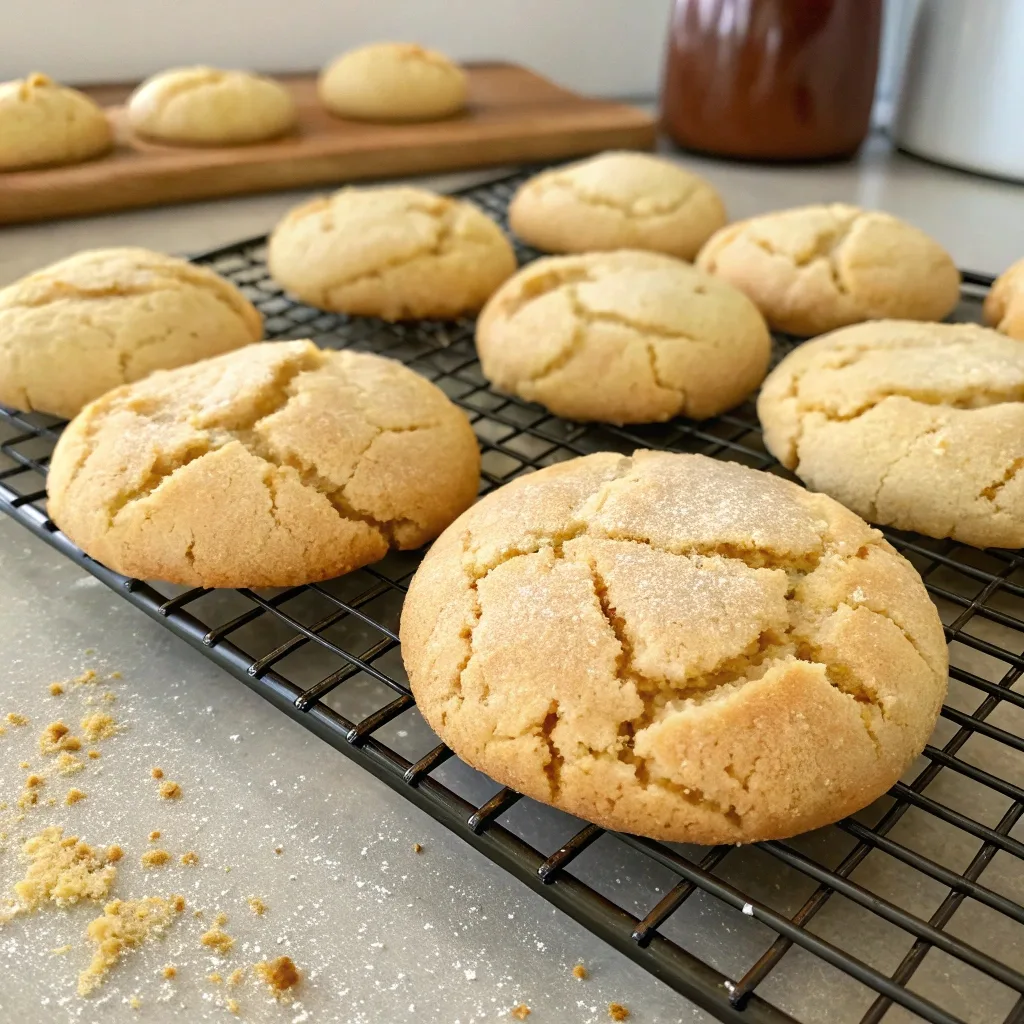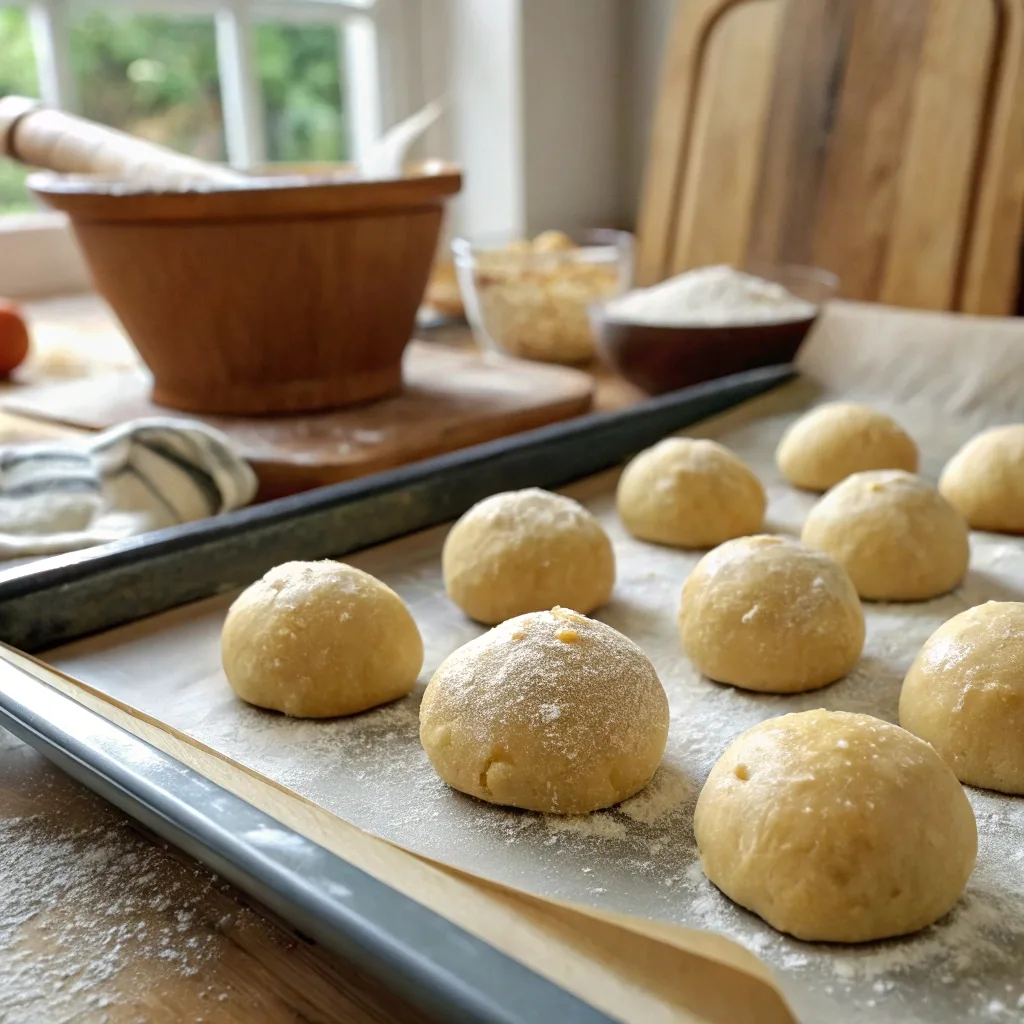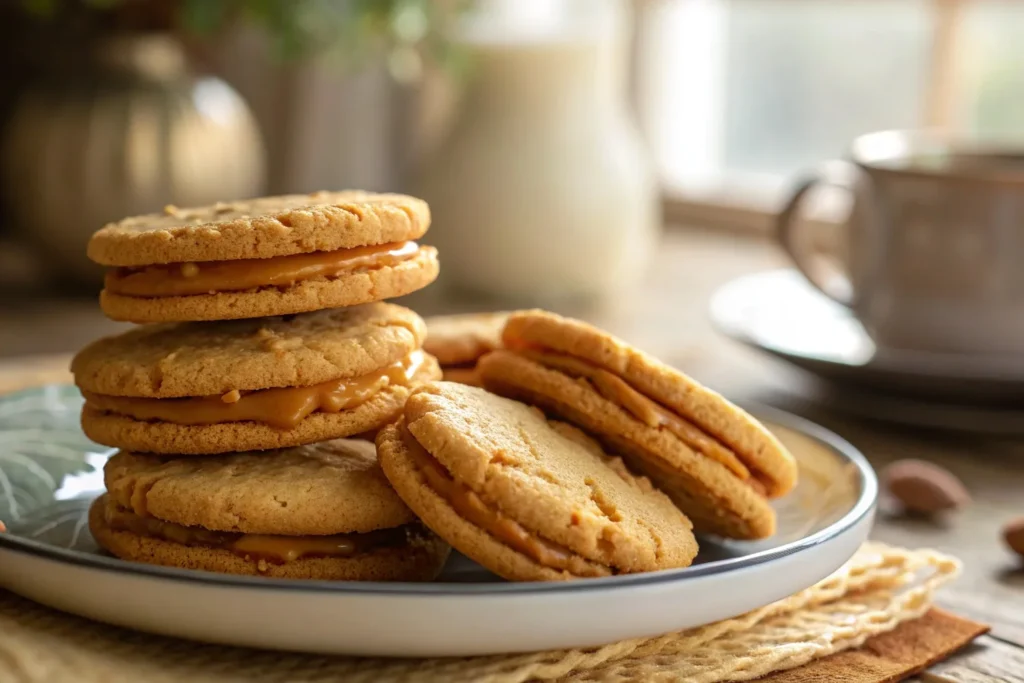Introduction
f you’ve ever wondered why your cookies are turning out flat, you’re not alone. Many bakers encounter this issue. Flat cookies often result from a few common mistakes in the baking process
Understanding the Science of Cookie Baking
To answer the question “Why do my cookies turn out so flat?”, it’s important to understand the science behind cookie baking. When cookies are baked, the heat causes the butter to melt and the baking soda or baking powder to release air bubbles. These air pockets are what help cookies rise and create that desired texture. However, if any part of the process goes wrong, it can lead to flat cookies.
- The chemical reactions involved in baking cause the dough to spread, but it should not spread too much. If your cookies are flat, it’s often due to issues with one or more ingredients.
The next sections will explore specific causes of flat cookies and how you can correct them.
Common Reasons Why Your Cookies Turn Out Flat
There are several common reasons that may answer the question, “Why do my cookies turn out so flat?”. These reasons can range from ingredient ratios to temperature issues. By identifying the cause, you can fix your cookie-making technique and avoid flat cookies.
Using Incorrect Ratios of Butter to Flour
One of the most common reasons cookies turn out flat is an incorrect ratio of butter to flour. If your recipe calls for too much butter, your dough will spread too much when baked, resulting in thin, flat cookies.
- Butter is a key ingredient that determines the texture of your cookies. If there’s too much butter, the dough can melt too quickly in the oven.
- Ensure that you measure your flour accurately and maintain the correct balance between flour and butter.
If your cookies are flat, consider reducing the amount of butter or increasing the flour slightly to get a firmer dough.
Overmixing the Dough: Why It Matters
Another reason your cookies might be flat is that the dough was overmixed. Mixing the dough too much can cause the formation of gluten, which makes the dough tough and less likely to spread evenly.
- Overmixing can also cause air bubbles to form, which leads to excessive spreading when the cookies bake.
To avoid this, mix your dough just until the ingredients are combined. Be gentle when mixing, especially after adding flour.
Baking at the Wrong Temperature
When you ask, “Why do my cookies turn out so flat?”, an incorrect baking temperature might be the culprit. If the oven is too hot, the cookies may spread too quickly. If the oven is too cool, the cookies may not spread enough and end up dense.
- Always ensure your oven is preheated to the correct temperature before baking.
- For most cookie recipes, the ideal temperature is 350°F (175°C). Baking at a high temperature can cause butter to melt too fast, creating that problem.
To correct this, check your oven with an oven thermometer and adjust the temperature if necessary.
Not Chilling the Dough Before Baking
Chilling your dough is another essential step. If you skip this step, the butter in the dough melts too quickly, causing the dough to spread too much during baking.
- Chilling your dough helps the fat in the butter solidify, preventing the cookies from spreading too thin in the oven.
To avoid flat cookies, chill the dough for at least 30 minutes before baking. For the best results, chill it overnight.
The Role of Ingredients in Cookie Structure
The structure of your cookies is influenced by the type and quality of ingredients you use. Each ingredient plays a vital role in determining whether your cookies will be thick and chewy or thin and flat.
Importance of Flour Quality and Measurement
The first ingredient to consider when asking “Why do my cookies turn out so flat?” is flour. If you use too little flour or the wrong kind of flour, your cookies may spread too much. On the other hand, too much flour can lead to dry, crumbly cookies.
- All-purpose flour is typically best for cookies, but make sure you measure it accurately. Use the spoon and level method to ensure you’re not adding too much flour.
- Sift your flour to avoid clumps and get an even texture.
Ensure that your flour measurement is correct to prevent flat cookies.
How Butter and Sugar Impact Cookie Spread
Butter and sugar play a key role in the spread of cookies. If either is used in excessive amounts or at the wrong temperature, the cookies can spread too much and turn out flat.
- Butter that’s too soft will cause the dough to spread excessively. Use butter that’s at room temperature to ensure the right consistency.
- The ratio of brown sugar to white sugar also impacts spreading. Brown sugar contains more moisture, leading to less spreading compared to white sugar.
Adjusting the amount of butter or sugar in your recipe can help prevent flat cookies.
The Effect of Leavening Agents
Leavening agents, such as baking powder and baking soda, are necessary to help cookies rise. When used in excess or insufficient amounts, they can lead to flat cookies or cause them to rise too quickly.
- If your dough doesn’t contain enough leavening agents, it may not rise properly and could result in flat cookies.
- Always follow your recipe’s specific measurements for leavening agents.
Ensure that the baking soda or baking powder used is the right amount to avoid flat cookies.
Baking Temperature and Timing Essentials
Both baking temperature and timing are crucial for preventing flat cookies. Too much heat or too little time can alter the texture and spread of the cookies.
How Oven Temperature Affects Cookies
As we discussed earlier, the oven temperature has a direct impact on whether your cookies will be flat or not. If your oven runs too hot, the butter in the dough melts too quickly, causing your cookies to spread too much.
- Check the temperature of your oven with an oven thermometer to make sure it’s accurate.
- Adjust the temperature by 10-15°F if necessary, depending on how your cookies turn out.
Correct oven temperature will help your cookies bake evenly and prevent them from turning out flat.
The Importance of Timing for Cookie Perfection
The amount of time your cookies spend in the oven also influences their final shape. If cookies bake for too long, they will become overcooked and spread too much. If they bake for too little time, they may not set properly.
- Check your cookies regularly and set a timer to ensure they bake for the correct amount of time. Usually, 8-12 minutes is sufficient.
Proper baking time helps maintain the right texture and prevents them from turning out flat.
How Altitude and Humidity Affect Cookies
Environmental factors such as altitude and humidity can also affect your cookies. High altitudes and humid climates may cause cookies to behave differently than expected, leading to flat cookies.
High-Altitude Baking Challenges
At higher altitudes, air pressure is lower, which can cause them to spread too much and result in flat cookies.
- Reduce the amount of baking soda or baking powder and increase the flour slightly to combat excessive spreading.
If you’re baking at high altitudes, try to make adjustments to the recipe.
Baking in Humid Environments
In humid environments, moisture in the air can cause your dough to become too wet, leading to flat cookies that spread too much.
- To fix this, use less liquid and increase the flour in your dough.
- Store your ingredients in a cool, dry place to prevent excess moisture.
If you live in a humid area, try to adjust your recipe accordingly .
Practical Solutions for Perfectly Plump Cookies

With a few simple adjustments, you can stop your cookies from turning out flat. Here are some practical solutions to try the next time you wonder why your cookies are spreading too much.
Adjusting Ingredient Ratios for Best Results
Experimenting with the ratios of butter and flour is often the best way to prevent flat cookies. Too much butter can cause excessive spreading, while too little flour can make the dough too soft.
- Try reducing the amount of butter slightly and increasing the flour to get a thicker dough that holds its shape better.
Small adjustments to ingredient ratios can solve the problem of flat cookies.
Tips for Mixing Dough the Right Way
Be careful not to overmix your cookie dough, as this can cause it to spread too much. Overmixing activates the gluten, making the dough tough and more likely to spread.
- Mix the ingredients just enough to combine them.
By mixing carefully, you can achieve dough that holds its shape and doesn’t result in flat cookies.
Why Chilling Cookie Dough Prevents Flatness
Chilling your dough is one of the most effective ways to prevent flat cookies. It helps the butter solidify, which keeps the cookies from spreading too much in the oven.
- Chill your dough for at least 30 minutes, or even longer if possible.
Dough chilling is a simple but crucial step in avoiding flat cookies.
Using Proper Baking Equipment and Tools
The equipment you use can also affect how your cookies bake. A heavy-duty baking sheet ensures even heat distribution, and using parchment paper or a silicone baking mat can help prevent sticking and ensure even baking.
- Make sure your baking sheets are not overcrowded to allow proper spreading.
By using the right equipment, you can improve the texture of your cookies and prevent them from turning out flat.
Troubleshooting: What Went Wrong?
If your cookies still turn out flat, it’s time to troubleshoot. Understanding what went wrong will help you prevent the same issue in future batches.
Analyzing the Results of Your Batch
Take a close look at the cookies to figure out what went wrong. Were they too thin? Did they spread too much during baking?
- Analyzing the results will help you pinpoint the issue, whether it’s too much butter, overmixing, or incorrect baking temperature.
Identifying the cause will make it easier to fix the problem next time.
Fixing Flat Cookies in the Next Attempt
Once you understand the cause of your flat cookies, you can make adjustments. Whether it’s adjusting the ingredient ratios, chilling the dough longer, or tweaking the baking temperature, small changes can help.
- Make note of the adjustments you made so you can replicate your success next time.
By troubleshooting and making adjustments, you can avoid flat cookies in the future.
Pro Tips for Baking Perfect Cookies Every Time
If you want to bake cookies that never turn out flat, here are some professional tips to ensure your cookies are always perfect.
Secrets from Professional Bakers
Professional bakers often have tricks that help them bake cookies perfectly every time. Some recommend chilling the dough for several hours, while others suggest using a cookie scoop for uniform sizes.
- Ask for advice from experienced bakers or watch tutorials to learn their techniques.
Learning from professionals can help improve your baking skills and give you better results.
Recommended Recipes and Variations
Try experimenting with different ingredients or recipes to see what works best for you. Chocolate chip cookies, oatmeal cookies, and other variations are all great places to start.
- Adjust the ingredients and techniques based on the results you want.
By experimenting with different recipes, you can perfect your cookie-baking technique and avoid flat cookies.
FAQs:
Baking cookies should be an enjoyable experience, but if you’re struggling with flat cookies, it can be frustrating. Here are the answers to some frequently asked questions about why cookies might not turn out as expected and how you can fix these issues.
How Do You Keep Cookies From Going Flat?

To prevent cookies from going flat, it’s important to follow a few simple steps:
- Chill the Dough: Chilling the dough for at least 30 minutes before baking helps the butter solidify, preventing excessive spreading.
- Use the Right Ratio of Ingredients: Ensure you’re using the correct ratio of butter to flour. Too much butter will cause the dough to spread too much, while too little flour will make the dough too soft.
- Don’t Overmix the Dough: Overmixing activates the gluten in the flour, which can make the cookies tough and cause them to spread too much. Mix just until the dough comes together.
How Can I Make My Cookies Fluffier Instead of Flat?
If you want fluffier cookies , try these tips:
- Add More Flour: Increasing the flour slightly will help the dough hold its shape and result in a thicker, fluffier cookie.
- Use Baking Powder Instead of Baking Soda: Baking powder causes the dough to rise more than baking soda, giving your cookies a fluffier texture.
- Avoid Overmixing the Dough: Overmixing causes the dough to spread too much and lose its fluffiness. Mix just enough to combine the ingredients.
Why Don’t My Cookies Stay Puffy?
If your cookies don’t stay puffy, it’s likely due to one or more of the following reasons:
- The Dough is Too Warm: Warm dough tends to spread too much in the oven. Chilling the dough before baking will help your cookies hold their shape.
- Incorrect Baking Temperature: If the oven is too hot, the cookies will spread too quickly, making them flat. Ensure your oven is preheated to the correct temperature (usually 350°F or 175°C).
- Not Enough Leavening Agents: Make sure you’re using the correct amount of baking powder or baking soda. If there’s too little, the cookies won’t rise properly and will stay flat.
Why Do My Cookies Always Turn Out Flat Even When I Follow the Recipe?
If your cookies always turn out flat despite following the recipe, here are some possible reasons:
- Oven Temperature Issues: Sometimes, the oven temperature may not be accurate. Use an oven thermometer to check that your oven is the correct temperature. If the oven is too hot, the cookies will spread too much.
- Incorrect Ingredient Measurements: Double-check the measurements of your ingredients. Too much butter or not enough flour can cause the dough to spread too much and lead to flat cookies.
- Not Chilling the Dough: If you skip the chilling step, the butter in the dough will melt too quickly in the oven, causing the cookies to spread too much.
By adjusting these factors, you’ll be able to fix the issue of flat cookies and achieve the perfect texture every time!
Wondering how to keep whipped cream from melting? Get all the tips in our article on keeping whipped cream on a cake and explore our recipe for cool whip cake decoration.
Conclusion
Baking cookies doesn’t have to result in disappointment. By understanding the causes of flat cookies and implementing the right strategies, you can ensure that your cookies are always thick, chewy, and delicious.
Key Takeaways and Final Advice
- Correct the ratios of butter to flour to avoid excessive spreading.
- Don’t overmix the dough, as this can lead to flat cookies.
- Always chill your dough and bake at the correct temperature.
- Consider environmental factors like altitude and humidity when baking.
With these tips in mind, you’ll never have to ask “Why do my cookies turn out so flat?” again!



